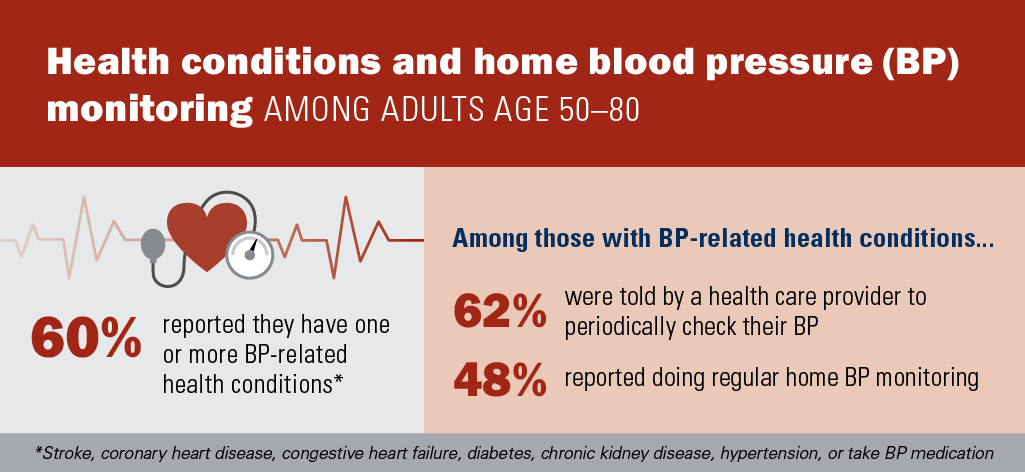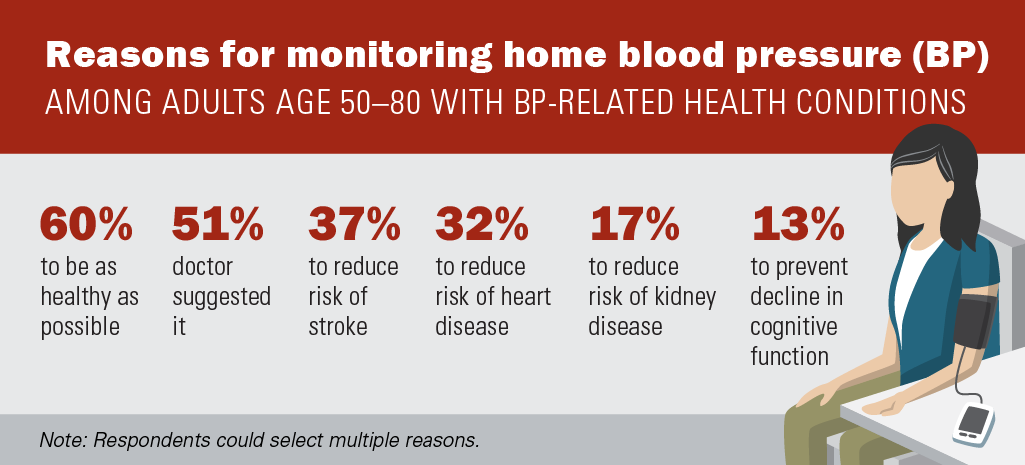
Millions of older adults have hypertension or other chronic health conditions that especially benefit from blood pressure (BP) control. When added to BP monitoring in the health care setting, monitoring one’s own BP at home or in other settings can result in improved BP control. In January 2021, the University of Michigan National Poll on Healthy Aging asked a national sample of adults age 50–80 about health conditions that especially benefit from BP control and their experiences with BP monitoring.
This report focuses on the 60% of adults age 50–80 who reported having one or more BP-related health conditions such as stroke, coronary heart disease, congestive heart failure, diabetes, chronic kidney disease, or hypertension, or who said they took a medication to control blood pressure.

Home BP monitoring
Among older adults with BP-related health conditions, 62% reported ever being told by a health provider to periodically check their BP outside the health care setting (referred to in this report as home BP monitoring), and 48% said they regularly monitor their BP. Those who were told by their health care provider to periodically check their blood pressure were more likely to do home BP monitoring than those who were not told (62% vs. 26%).
The most common reasons adults age 50–80 with BP-related conditions reported doing home BP monitoring were to be as healthy as possible (60%); because their doctor suggested it (51%); to reduce the risk of stroke (37%), heart disease (32%), or kidney disease (17%); and to prevent a decline in cognitive function (13%).
One in ten older adults with BP-related conditions (10%) were very concerned about their blood pressure, 37% were somewhat concerned, 38% were not very concerned, and 15% were not at all concerned. Home BP monitoring was more likely for older adults with BP-related conditions who were very concerned about their BP (63%) compared to those somewhat concerned (54%), those not very concerned (44%), and those not at all concerned (32%).
Among those with BP-related health conditions, adults age 65–80 were more likely than those age 50–64 to do home BP monitoring (52% vs. 45%), and adults with excellent or very good mental health were more likely to do home BP monitoring than those with good, fair, or poor mental health (52% vs. 41%).
Three in four older adults with BP-related health conditions (74%) said they owned a home BP monitor, including 55% who reported using their monitor and 19% who did not.
Older adults who owned a home BP monitor were more likely to check their blood pressure regularly compared with those who did not own a monitor (59% vs.18%). Among those with BP-related health conditions who owned and used a home BP monitor, 14% used it daily, 21% several times a week, 16% once a week, 28% one to three times per month, and 20% less than once per month.
Among those with BP-related health conditions who did not own a home BP monitor, over half (54%) said it was because it was not needed or they never considered it.
Sharing BP readings with health care providers
For older adults with BP-related health conditions who used their home BP monitor regularly, half (50%) reported sharing their home BP readings with their health care provider. Those who shared home BP readings with their health provider were more likely to do home BP monitoring regularly than those who did not share their readings (88% vs. 67%). Most older adults who shared their home BP readings received feedback from their health care provider (88%).

Implications
Clinical guidelines recommend adults with BP-related health conditions such as stroke, coronary heart disease, congestive heart failure, diabetes, chronic kidney disease, or hypertension monitor their blood pressure at home. Regular home BP monitoring is associated with better BP control which can reduce the risk of stroke, heart disease, and kidney disease, and may also prevent cognitive decline.
Yet this poll found that more than half of adults age 50–80 who could benefit from blood pressure control do not do home BP monitoring regularly, and nearly two in five of them said a provider had never told them to periodically check their blood pressure outside the health care setting. More than half of older adults without a home BP monitor said it was because it was not needed or they never considered it, and one in five of those with a home BP monitor said they did not use it.
About half of adults age 50–80 with BP-related conditions who said they monitor their blood pressure at home or in another setting said they did so because a doctor suggested it. Health care providers can encourage home BP monitoring by educating patients on how and when to monitor their BP at home. Since many older adults said they were motivated to monitor blood pressure to be as healthy as possible, health care providers should continue to educate their patients about the importance of blood pressure control in reducing the risk of cardiovascular events, heart failure, and kidney disease progression, and provide feedback on home BP monitor readings.
Older adults should have their BP checked periodically and talk with their health care providers about whether they should regularly monitor their blood pressure at home and share their blood pressure readings. Home BP monitoring can be an important tool for patient-provider communication and for effectively managing many chronic health conditions.
Data Source and Methods
This National Poll on Healthy Aging report presents findings from a nationally representative household survey conducted exclusively by Ipsos Public Affairs, LLC (“Ipsos”) for the University of Michigan’s Institute for Healthcare Policy and Innovation. National Poll on Healthy Aging surveys are conducted by recruiting from Ipsos KnowledgePanel®, the largest national, probability-based panel in the U.S.
This survey module was administered online in January 2021 to a randomly selected, stratified group of older adults age 50–80 (n=2,023). The completion rate was 77% among panel members contacted to participate. The sample was subsequently weighted to reflect population figures from the U.S. Census Bureau. The margin of error is ±1 to 3 percentage points for questions asked of the full sample and higher among subgroups.
Findings from the National Poll on Healthy Aging do not represent the opinions of the University of Michigan. The University of Michigan reserves all rights over this material.
Read other National Poll on Healthy Aging reports and about the poll's Michigan findings, and learn about the poll methodology.
Citation
Levine D, Springer M, Kullgren J, Singer D, Solway E, Kirch M, Malani P. Home Blood Pressure Monitoring Among Older Adults. University of Michigan National Poll on Healthy Aging. October 2021. Available at: https://dx.doi.org/10.7302/3238
Kimson Johnson, MSW, a doctoral student from the U-M School of Public Health; Emmanuel Quaye, MHS, a medical student from the U-M Medical School, and Bailey Reale, MPH, a medical student from the Lake Erie College of Osteopathic Medicine also contributed to this report.
Scholarly Publications
Springer MV, Malani P, Solway E, et al. Prevalence and frequency of self-measured blood pressure monitoring in US adults aged 50-80 years. JAMA Netw Open. 2022;5(9):e2231772. doi:10.1001/jamanetworkopen.2022.31772